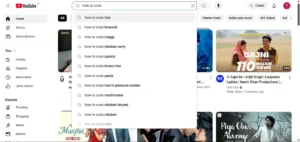Ever wonder why some YouTube videos explode with millions of views while others struggle to reach even a hundred? The secret often lies in one crucial element: YouTube keyword research. The right keywords can transform your channel from a collection of random uploads into a strategic, growth-driven machine that consistently attracts viewers and builds a loyal audience.
YouTube keyword research isn’t just about stuffing popular terms into your video titles. It’s about understanding what your audience is actively searching for and positioning your content to be discovered at exactly when they need it. If done correctly, this strategy drives views, increases watch time, and accelerates subscriber growth, turning your YouTube channel into a predictable source of engagement and success.
In this comprehensive guide, you’ll discover how to move beyond the hit-or-miss approach of random video uploads. We’ll walk through proven strategies, essential tools, and actionable techniques that successful creators use to dominate YouTube search results and build thriving channels. You’ll learn how to find YouTube keywords that drive real results and develop a robust YouTube keyword strategy that grows your channel consistently.
What Is YouTube Keyword Research?
YouTube keyword research is the process of discovering the specific words and phrases people type into YouTube’s search bar when looking for content. These keywords become the foundation of your YouTube SEO strategy, appearing in your video titles, descriptions, tags, and even spoken content.
Think of keywords as the bridge between what people want to watch and what you create. When someone searches for “beginner guitar lessons,” they’re expressing a clear intent – they want to learn guitar basics. If your video is optimized for this keyword, YouTube’s algorithm can connect your content with that searcher, creating a perfect match.
Why YouTube Keyword Research Matters
YouTube operates as the world’s second-largest search engine, processing over 3 billion searches every month. This massive search volume creates enormous opportunities for content creators who understand how to tap into it effectively.
Unlike traditional Google searches, YouTube keyword research focuses on video-specific viewer intent. People come to YouTube for visual learning, entertainment, and problem-solving that requires demonstration. This creates unique opportunities for creators who align their content with these viewing behaviors.
Effective keyword research impacts every aspect of your channel’s growth:
- Discoverability: Helps your videos appear in search results and suggested video feeds
- Engagement: Attracts viewers who are genuinely interested in your content topic
- Channel Growth: Builds topical authority and attracts subscribers interested in your niche
Essential YouTube Keyword Research Tools
Success in YouTube keyword research requires the right tools to increase YouTube video visibility. Let’s explore the most effective options, from free native tools to powerful third-party solutions.
1. YouTube’s Native Tools
YouTube Autocomplete serves as your most accessible starting point. When you begin typing in YouTube’s search bar, the platform provides real-time suggestions based on actual user searches. These suggestions represent genuine search demand, making them invaluable for content planning.
Try this experiment: type “how to cook” into YouTube’s search bar and observe the autocomplete suggestions. You’ll see specific queries like “how to cook pasta,” “how to cook chicken breast,” and “how to cook rice.” Each suggestion represents a potential video topic with proven search demand.

Youtube Search
YouTube Analytics provides crucial insights through its Traffic Sources section. Navigate to your channel’s Analytics, then click on “Traffic Sources” and select “YouTube Search.” This reveals the exact search terms that led viewers to your videos, helping you understand which keywords already work for your content.
2. Google Tools
Google Trends proves essential for understanding keyword seasonality and comparing topic popularity over time. This tool helps you identify trending topics and understand when certain keywords peak in popularity. For example, “tax preparation” searches spike dramatically between January and April each year.
Google Keyword Planner, while designed for Google Ads, provides valuable context for broader keyword research. It offers insights into search volume and competition levels, though remember that it shows Google search data rather than YouTube-specific metrics.
3. Third-Party Solutions
TubeBuddy offers comprehensive YouTube keyword research features, including keyword scores, competition metrics, and tag suggestions. The platform’s Keyword Explorer tool analyzes search volume and competition specifically for YouTube, helping you identify opportunities within your niche.
VidIQ delivers powerful keyword research capabilities with competition scores and trending video analysis. The platform includes AI-powered features for generating keyword ideas and provides insights into competitor strategies.
Additional tools like KeywordTool.io and Morningfame extend your research capabilities, offering various approaches to YouTube keyword discovery from autocomplete scraping to AI-powered suggestion generation.
How to Identify High-Potential Keywords
Finding the right keywords requires balancing search volume with competition. The sweet spot lies in discovering the best keywords for YouTube videos with enough search volume, yet modest creator competition to keep things manageable.
1. Assessing Search Volume vs. Competition
High-potential keywords typically feature monthly search volumes exceeding 1,000 queries while having fewer than 50 competing videos with well-optimized titles and descriptions. These keywords offer the best opportunity for ranking success.
Long-tail keywords present particularly valuable opportunities for smaller channels. Instead of targeting broad terms like “makeup tutorial,” consider specific phrases like “natural makeup tutorial for oily skin.” These longer, more specific phrases face less competition while still attracting engaged viewers.
2. Understanding Viewer Intent
YouTube keyword research requires understanding different types of viewer intent:
Informational searches like “how to change car oil” indicate viewers want to learn specific skills. These searches work well for tutorial-style content.
Commercial searches like “best budget smartphones 2025” suggest comparison shopping behavior. These searches suit review and comparison videos.
Entertainment searches like “funny cat videos” indicate viewers seeking enjoyment. These searches work well for entertainment-focused content.
Successful keyword strategies align your content format with search intent, ensuring you attract viewers who genuinely want what you’re offering.
3. Using Related Searches and “People Also Ask”
YouTube’s related search suggestions and “People Also Ask” features reveal long-tail and question-based keywords you might otherwise overlook. These features help uncover specific questions your audience is asking, providing direct content ideas that address viewer needs.
Leverage the autocomplete feature systematically by adding different modifiers (who, what, how, why, when, where) to your base keywords. This approach helps you discover comprehensive keyword variations and content opportunities.
Implementing Keywords for Maximum Impact
Effective keyword implementation requires strategic placement across all your video elements.
1. Optimizing Your Video Title
Video titles represent your most important SEO element. Include your target keyword at the beginning of the title when possible, as YouTube gives more weight to terms appearing early. Keep titles between 40-60 characters for optimal display across devices.
Effective titles balance keyword optimization with click-through rate optimization by including compelling elements like numbers, power words, or emotional triggers.
2. Crafting Compelling Descriptions
Video descriptions should be at least 250 words and include your primary keyword 2-3 times, particularly in the first 150 characters. This opening section appears in search results and suggested video previews.
Include secondary and long-tail keywords naturally throughout the description, along with relevant links, timestamps, and calls to action. This comprehensive approach helps YouTube understand your content while providing value to viewers.
3. Tag Strategy
Use 5-8 high-quality tags that mix broad and specific terms. Start with your most important keyword as the first tag, then include variations, synonyms, and related terms. Understanding YouTube tags for ranking helps YouTube categorize your content and match it with relevant searches.
4. Thumbnails and Closed Captions
While thumbnails aren’t directly crawled for keywords, they significantly impact click-through rates, which directly influence search rankings. Closed captions and transcripts provide additional text for search engines to crawl, increasing keyword density and helping videos rank for more diverse terms.
Monitoring Performance and Refining Your Strategy
Successful YouTube keyword research requires ongoing monitoring and refinement based on performance data.
Key Metrics to Track
Monitor these essential metrics to evaluate keyword strategy effectiveness:
- Impressions and Click-Through Rate (CTR): Measure how often your videos appear in search and how frequently viewers click
- Watch time and average view duration: Indicate content quality and viewer satisfaction
- Traffic sources: Show which search terms and discovery methods drive views
- Subscriber growth by video: Reveals which content and keywords attract long-term audience growth
While YouTube Analytics provides essential metrics, understanding broader analytics tracking principles can help you make more informed decisions about your overall digital marketing strategy.
A/B Testing and Iteration
Use YouTube Studio’s “Test & Compare” feature to test different thumbnails simultaneously. Monitor performance after making strategic changes to video titles, tracking metrics like CTR and search ranking position.
Regular analysis of YouTube Analytics helps identify successful keyword patterns and content gaps. Use this data to refine your keyword strategy, focusing on terms that drive engaged viewers and avoiding those that attract irrelevant traffic.
Beyond organic search optimization, consider exploring paid YouTube ad formats to amplify your content’s reach and accelerate channel growth.
Your Next Steps to Keyword Success
YouTube keyword research transforms from a one-time task into an ongoing strategic process that evolves with your channel and audience. By systematically implementing these research methods, organization strategies, and optimization techniques, you can build sustainable growth through improved discoverability and viewer engagement.
The key lies in understanding that effective keyword research serves both the YouTube algorithm and your actual human audience, creating content that ranks well while delivering genuine value to viewers.
Start by choosing one keyword research tool from this guide and spending 30 minutes exploring keyword opportunities in your niche. Need expert guidance? Contact us if you’re ready to accelerate your YouTube growth with a data-driven keyword strategy. Sometimes the fastest path to success is learning from someone who’s already mastered these techniques and can provide customized guidance for your specific channel and goals.


